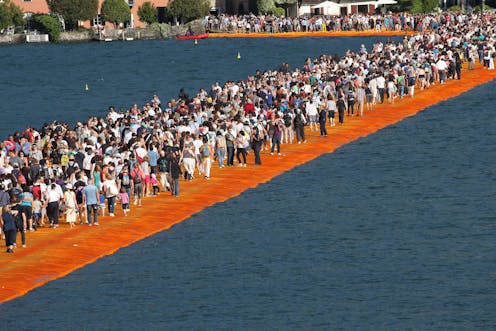Bulgarian artist Christo – who is best known for his massive “wrapping” of buildings and other monuments – has unveiled his latest installation, The Floating Piers. If you visit Italy’s Lake Iseo before July 3, you can experience what it’s like to walk on water.
On setting foot on the piers, a floating dock system of 220,000 high-density polyethylene cubes which undulate with the waves, visitors will experience the closest approximation to what it’s like to walk on water. Seem like a gimmick, or even more of an amusement park attraction than high art? Maybe, but installation art, in its relatively short history, has always been controversial.
The use of installation in contemporary art began to develop in the 1970s as a way of democratising the art experience. Installation enables the viewer to have a more active role in the consumption of the artwork, rather than passively viewing it. As such, the meaning of the artwork was no longer just about what the artist wanted to express, but about the viewer’s experience of and interaction with it.

For example, one of Allan Kaprow’s earliest installations, Apple Shrine, involved visitors navigating a basement labyrinth of chicken wire, newspaper, cloth and straw, at the end of which they were allowed to take a piece away with them. They had to choose between a real apple, which they could literally consume (eat), or a fake one, which they could keep and preserve forever.
Art in public
Installation artists seek to move art into the public space, so that those who don’t usually frequent galleries could encounter it. This doesn’t often pan out as expected. One infamous example was Richard Serra’s Tilted Arc, a site-specific installation on New York City’s busy Federal Plaza, constructed in 1981. The point was to alter the individual’s path as she or he crossed the plaza. It sparked such a strong reaction — people were annoyed that they had to go around it, not to mention the fact that many found it ugly — that a public trial was held and a jury voted to remove it.
Because of its strong imposition on the landscape and in public spaces, installation art can also be effective in communicating a political or social message. At the end of last year, Danish-Icelandic artist Olafur Eliasson, together with the geologist Minik Rosing, installed Ice Watch — 12 blocks of ice, taken from icebergs from a fjord in Greenland — in the Place du Pantheon during COP21, the Paris Climate Conference 2015. Over the course of 12 days, those 12 blocks, arranged in a clock formation, melted away. The artist made climate change and its effects, for which there are still many sceptics, visible to all — not just the scientists and experts inside the meetings of COP21.

In February 2016, Chinese artist Ai Weiwei, who is outspoken on the subject of human rights and whose work is often political, covered the columns of the façade of Berlin’s Konzerthaus with bright orange life vests taken from Lesbos, the Greek Island that has become a gateway for refugees fleeing to Europe. The installation coincided with the Berlinale Film Festival. Although the intention was to commemorate those who died at sea in their attempt to escape war and persecution, the artist was criticised for the location of installation, seeing as Germany has taken in more refugees than any other European nation.
Art and beauty
But such “public” art does not always have to be political. The work that Christo – the walking on water artist – began creating in the 1960s with his partner Jeanne-Claude didn’t aim to pander to particular debates. They maintained that their principle aim was to create objects of beauty. By intervening in a landscape or wrapping up a building in cloth, such as the Reichstag in Berlin, they invited the viewer to look again, see something anew, and appreciate the aesthetic qualities the new artwork brings. The artists continued to make installations together until 2009, when Jeanne-Claude died.
The Floating Piers is Christo’s first installation since his partner’s death. Similarly, aesthetics and emotion seem to be the principle message.
The public nature of all of these installations enables the beauty of contemporary art to be appreciated by those who wouldn’t normally set foot into an art museum or gallery – and the placement of some of them allows for a social and political message to be communicated to a wider audience. While Christo’s piece enables the visitor to walk on water, Eliasson’s and Weiwei’s works both bring home powerful messages about important social issues in a more visceral manner than perhaps a news item or report might. And that, after all, is the power of installation art.






